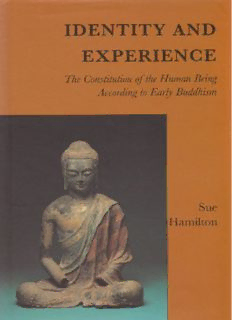
Identity and Experience: The Constitution of the Human Being According to Early Buddhism PDF
Preview Identity and Experience: The Constitution of the Human Being According to Early Buddhism
IDENTITY AND EXPERIENCE Frontispiece :t hd emon ofDukkha I D E N T I T Y A N D E X P E R I E N C E The Constitution ofthe Human Being According to Early Buddhism SUE HAMILTON LUZAC 0 RIENTAL LUZAC ORIENTAL 46 Great Russell Street, London WCI 1996 O Sue Hamilton 1996 ISBN I 898942 10 2 All rights reserved: no part of this publication may be reproduced, stored in a retrieval system, or transmitted in any form or by any means, electronic, mechanical, photocopying, recording, or otherwise without prior permission of the Publishers. Printed and bound in Great Britain by Bookcraft (Bath) Limited, Midsomer Norton, Avon For Ma, with love and thanks CONTENTS Foreword Acknowledgements Abbreviations xiii Introduction I. The Riipakkhandha Introduction The RipaWrhandha The Senses Manas and Dhammi 11. The VidanZkhandha Introduction to the AnipaWchandhas The Vedanaandha Phassa SaEEi as Apperception SaEEa' as Conception Samkhira in the TilaWd2av Formula Samkhira in the Paficcasamuppida Formula SapkhGra as a Khandha The Cyclic Causal Nexus VIII Identity and Experience v. The ViiZEiykkhandha Vin"n"ipza s a K?zan&a I. KfiKa'pz as impermanent 2. Kn"n"a'p.za s 'consciousness of 3. Kn"n"iij?aa s a factor in cognition 4. Kfifi& as providing continuity 5. Efin"a'pa s evolving Summary Vin"n"ip~a nd fiya Manas and Citta VIII. The Attitude towards the Body Conclusion Bibliography Short Glossary General Index Index of Textual Sources Foreword "WHATA RE LITTLE BOYS MADE OFF?",a sks the nursery rhyme, and reli- gious traditions ask the same question. Though the Buddha apparently denied that the human being contains something called a soul, what he meant by the denial, or by the word in his language which we translate "soul", has rarely been scrutinised. In ancient India the Buddha's teaching was commonly summed up in a verse which says that he taught "the cause of things which arise from a cause, and their cessation too." He explained life as a causal process which normally leads to suffering; salvation can only come from reversing that process. The Buddhist texts assert that a human being - indeed, any being living in our world - has five constituents, one physical and four mental: feelings, apperceptions, volitions, consciousness. The word for these constituents is "bundles", to show that they are plural. So it looks at first glance as if the Buddha was offering two analyses: the static, synchronic analysis of a person into "bundles", and the dynamic, diachronic analysis into a causal chain of events. Sue Hamilton began by asking the nursery rhyme question and analysed what the texts have to say about the "bundles". She has found an exciting answer: they are bundles of experiences. On close scrutiny it turns out that the Buddha did not ask "What is a man?" but "How is man?". For objects he substituted processes. And his analysis of the human condition was an integrated whole. This book is a breakthrough in our understanding of the earliest Buddhism and offers a firm foundation for future research. Richard Gombrich Oxford, March 1995 Acknowledgements THISB OOK IS A SLIGHTLY revised version of my Oxford D.Phil thesis. Though I hope it will be of interest to as wide a readership as possible given its specialised topic (a brief glossary is given for the assistance of the more general reader), it is primarily intended to be a contribution to Buddhist studies. To this end, I hope it will not only answer some questions and clarify some areas of ambiguity but also stimulate further questions and on-going research, for myself and for others. As my work on this subject proceeded, I became only too aware of the size of the task I had undertaken, and there is considerable scope for adding to the material gathered together here. This reflects not just the extent of textual references to this topic but also the centrality of it in the context of the teachings of the Buddha. I would add that this book was already tied into publishing schedules by the time I recently became acquainted with certain relevant issues in the Western philosophical tradition. An earlier acquaintance with these might well have clarified my mind and/or prompted me to write (some- times very) differently on certain points. But the fact that I was not familiar with them does mean that what is contained herein has not had any Western philosophical thought projected onto the Buddhist material: I was not 'looking for parallels'. (That might happen later.) So while any reader with knowledge of Western philosophy will therefore have to bear with my ignorance, the parallels that there are can the more eloquently speak for themselves. It is a happy custom that writers of books have an opportunity to thank those who have made a notable contribution, in one way or another, to its production. In my case, thanks are owed to many. Alexis Sanderson was an inspiring teacher in the early part of my graduate studies at Oxford. Richard Gombrich, who supervised my D.Phi1, was an invaluable source of advice, thought-provoking comments and constructive criticism. The examiners of the thesis, Lance Cousins and Paul Williams, made useful criticisms and suggestions, some of which have been incorporated in this book: any omissions or errors that remain are entirely my own. During the years of my graduate studies I was fortunate enough to be a member of
